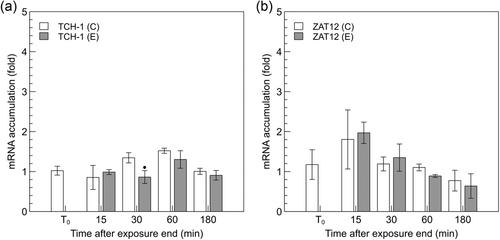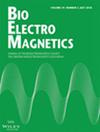下载PDF
{"title":"Changes in Gene Expression After Exposing Arabidopsis thaliana Plants to Nanosecond High Amplitude Electromagnetic Field Pulses","authors":"Alexis Porcher, Nancy Wilmot, Pierre Bonnet, Vincent Procaccio, Alain Vian","doi":"10.1002/bem.22475","DOIUrl":null,"url":null,"abstract":"<p>The biological effects of exposure to electromagnetic fields due to wireless technologies and connected devices are a subject of particular research interest. Ultrashort high-amplitude electromagnetic field pulses delivered to biological samples using immersed electrodes in a dedicated cuvette have widely demonstrated their effectiveness in triggering several cell responses including increased cytosolic calcium concentration and reactive oxygen species (ROS) production. In contrast, the effects of these pulses are poorly documented when electromagnetic pulses are delivered through an antenna. Here we exposed <i>Arabidopsis thaliana</i> plants to 30,000 pulses (237 kV m<sup>−1</sup>, 280 ps rise-time, duration of 500 ps) emitted through a Koshelev antenna and monitored the consequences of electromagnetic fields exposure on the expression levels of several key genes involved in calcium metabolism, signal transduction, ROS, and energy status. We found that this treatment was mostly unable to trigger significant changes in the messenger RNA accumulation of calmodulin, Zinc-Finger protein <i>ZAT12</i>, NADPH oxidase/respiratory burst oxidase homolog (<i>RBOH</i>) isoforms D and F, Catalase (<i>CAT2</i>), glutamate-cystein ligase (<i>GSH1</i>), glutathione synthetase (<i>GSH2</i>), Sucrose non-fermenting-related Kinase 1 (<i>SnRK1</i>) and Target of rapamycin (<i>TOR</i>). In contrast, Ascorbate peroxidases <i>APX-1</i> and APX-6 were significantly induced 3 h after the exposure. These results suggest that this treatment, although quite strong in amplitude, is mostly ineffective in inducing biological effects at the transcriptional level when delivered by an antenna. © 2023 The Authors. Bioelectromagnetics published by Wiley Periodicals LLC on behalf of Bioelectromagnetics Society.</p>","PeriodicalId":8956,"journal":{"name":"Bioelectromagnetics","volume":"45 1","pages":"4-15"},"PeriodicalIF":1.2000,"publicationDate":"2023-07-06","publicationTypes":"Journal Article","fieldsOfStudy":null,"isOpenAccess":false,"openAccessPdf":"https://onlinelibrary.wiley.com/doi/epdf/10.1002/bem.22475","citationCount":"0","resultStr":null,"platform":"Semanticscholar","paperid":null,"PeriodicalName":"Bioelectromagnetics","FirstCategoryId":"99","ListUrlMain":"https://onlinelibrary.wiley.com/doi/10.1002/bem.22475","RegionNum":3,"RegionCategory":"生物学","ArticlePicture":[],"TitleCN":null,"AbstractTextCN":null,"PMCID":null,"EPubDate":"","PubModel":"","JCR":"Q3","JCRName":"BIOLOGY","Score":null,"Total":0}
引用次数: 0
引用
批量引用
Abstract
The biological effects of exposure to electromagnetic fields due to wireless technologies and connected devices are a subject of particular research interest. Ultrashort high-amplitude electromagnetic field pulses delivered to biological samples using immersed electrodes in a dedicated cuvette have widely demonstrated their effectiveness in triggering several cell responses including increased cytosolic calcium concentration and reactive oxygen species (ROS) production. In contrast, the effects of these pulses are poorly documented when electromagnetic pulses are delivered through an antenna. Here we exposed Arabidopsis thaliana plants to 30,000 pulses (237 kV m−1 , 280 ps rise-time, duration of 500 ps) emitted through a Koshelev antenna and monitored the consequences of electromagnetic fields exposure on the expression levels of several key genes involved in calcium metabolism, signal transduction, ROS, and energy status. We found that this treatment was mostly unable to trigger significant changes in the messenger RNA accumulation of calmodulin, Zinc-Finger protein ZAT12 , NADPH oxidase/respiratory burst oxidase homolog (RBOH ) isoforms D and F, Catalase (CAT2 ), glutamate-cystein ligase (GSH1 ), glutathione synthetase (GSH2 ), Sucrose non-fermenting-related Kinase 1 (SnRK1 ) and Target of rapamycin (TOR ). In contrast, Ascorbate peroxidases APX-1 and APX-6 were significantly induced 3 h after the exposure. These results suggest that this treatment, although quite strong in amplitude, is mostly ineffective in inducing biological effects at the transcriptional level when delivered by an antenna. © 2023 The Authors. Bioelectromagnetics published by Wiley Periodicals LLC on behalf of Bioelectromagnetics Society.
拟南芥暴露于纳秒级高幅电磁场脉冲后的基因表达变化。
接触无线技术和联网设备产生的电磁场对生物的影响是一个特别值得关注的研究课题。使用专用比色皿中的浸入式电极向生物样本输送超短高振幅电磁场脉冲,已广泛证明它们能有效触发多种细胞反应,包括增加细胞膜钙浓度和产生活性氧(ROS)。相比之下,当电磁脉冲通过天线传输时,这些脉冲的效果却鲜有记录。在这里,我们将拟南芥暴露于通过科舍廖夫天线发射的 30,000 个脉冲(237 kV m-1、280 ps 上升时间、500 ps 持续时间)中,并监测了电磁场暴露对涉及钙代谢、信号转导、ROS 和能量状态的几个关键基因表达水平的影响。我们发现,这种处理在很大程度上无法引发钙调蛋白、锌指蛋白 ZAT12、NADPH 氧化酶/呼吸猝灭氧化酶同源物(RBOH)异构体 D 和 F、过氧化氢酶(CAT2)、谷氨酸-半胱氨酸连接酶(GSH1)、谷胱甘肽合成酶(GSH2)、蔗糖不发酵相关激酶 1(SnRK1)和雷帕霉素靶(TOR)的信使 RNA 积累发生显著变化。相比之下,抗坏血酸过氧化物酶 APX-1 和 APX-6 在暴露 3 小时后被显著诱导。这些结果表明,这种处理方法虽然振幅很大,但通过天线传递时在转录水平上对生物效应的诱导大多无效。© 2023 作者。生物电磁学》由 Wiley Periodicals LLC 代表生物电磁学协会出版。
本文章由计算机程序翻译,如有差异,请以英文原文为准。


 求助内容:
求助内容: 应助结果提醒方式:
应助结果提醒方式:


